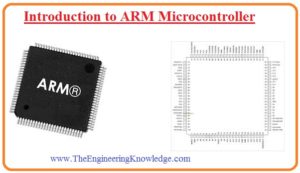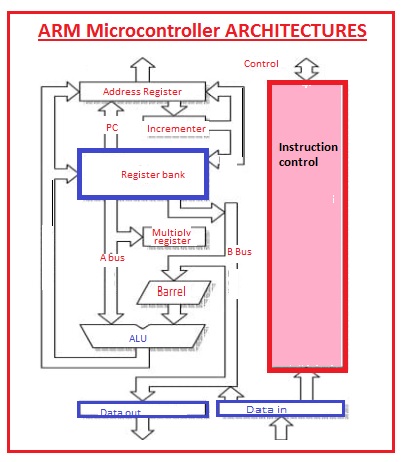 Hi, students welcome to our new post. In today’s post, we will have a detailed look at Introduction to ARM Microcontroller. The ARM microcontroller most commonly used controller in different types of embedded projects and in different types of industrial projects it uses due to different types of advantages over other controllers and modern structures.
Hi, students welcome to our new post. In today’s post, we will have a detailed look at Introduction to ARM Microcontroller. The ARM microcontroller most commonly used controller in different types of embedded projects and in different types of industrial projects it uses due to different types of advantages over other controllers and modern structures.
Due to lower cost and better operation, it is mostly used in different types of projects such as the different categories of control systems, wireless circuits, sensing devices, and automobiles. This controller is a memory of different types of central processing units and is based on RISC. It is available in thirty-two-bit and sixty-four-bit configurations. Its processor is based on RISC which has a large operating speed and executes the least number of commands. In today’s post, we will have a detailed look at its working, operation, pinouts, and some other related factors. So let’s get started with Introduction to ARM Microcontroller.
Introduction to ARM Microcontroller
- The ARM stands for Advanced RISC Machine and it is based on the RISC architecture which is a commonly used computer configuration.
- It is a thirty-two-bit module that was created by Acron Computers in 1987.
- There are different types of MCU manufacturers that create this board such as ST Microelectronics and Motorola.
- This module has different categories such as ARMv1, and ARMv2, and each module provides its own features.
- As it uses RISC or a reduced instruction set which helps to reduce the physical dimension of the integrated circuit it uses a small number of transistors for its creation.
- As this model exists in small size different devices such as mobile phones, tablets, and other handheld devices comprise this board.
- With the combination of an ARM with random access memory and read-only memory, we get different types of controllers such as LPC2148.
ARM Microcontroller ARCHITECTURES
- In ARM controller RISC, load-store architecture exists in this board.
- Different types of registers are used in this board which helps in the manipulation of memory.
- The set of instructions is used in the board but the main function is to decrease the time required by every instruction.
- The processor used in the ARM controller is cortex M3 which is a high-speed and thirty-two-bit, and it offers numerous features to the users.
- The architecture of this board is Harward architecture has distinct data and instruction buses to transmit data to the random access memory and read-only memory unknit.
- For execution, fetching, decoding, and different types of commands three-stage pipeline is used.
- The processor of this board uses thumb commands based on the thumb two techniques, so it decreases the memory needed for the program and makes sure of a higher density of coding.
- This model comprises a thirty-two-bit architecture which provides better performance in the execution of commands.
Features of ARM Microcontroller
- These are some important features of this controller which are described here with the details.
- This board comprises of thirty-two-bit central processing unit which is high-speed.
- It comprises the three-stage pipeline.
- This board uses the thumb 2 technique.
- This module is compatible with the different types of tools and RTOS.
- It is compatible with the sleep mode of operation.
- It has the ability to control different types of software
Technical Features of ARM Microcontroller
| Feature | Description |
|---|---|
| Architecture | ARM Cortex-M Series |
| Clock Speed | 16MHz, megahertz |
| Flash Memory | programmable, non-volatile memory can have kilobyte and megabyte range |
| RAM | volatile, data storage |
| GPIO Pins | programmable digital Iinput and outputs |
| UART/USART | Serial communication, |
| SPI | used for communication |
| I2C | Inter-Integrated Circuit |
| PWM | Pulse Width Modulation outputs |
| ADC | Analog to Digital Converter, |
| Timers/Counters | Counting and timing capabilities |
| Interrupts | Hardware and software interrupts |
| Watchdog Timer | System reset on timeouts |
| Power Management | low-power operation Sleep modes, |
| DMA Controller | it used for data transfer |
| Real-Time Clock (RTC) | it employed for correct timekeeping |
| USB | Universal Serial Bus connection |
| Ethernet | An ethernet connection was made here |
| CAN | Controller Area Network communication protocol |
| Operating Voltage Range | supply voltage provided here |
| Temperature Range | Operating and storage temperature range |
| Debug Interface | JTAG, SWD for debugging and programming |
| Security Features | secure boot, Hardware encryption, memory protection |
| Package | DIP, BGAQFP, |
| Ecosystem | libraries, Development tools, and community support |
Register Modes ARM Microcontroller
- It is based on load-store RISC architecture which defines that its core directly operates memory.
- Register used for data processing and information of memory unit with use of address bus.
- It comes with thirty-seven registers 32 are for general purposes and 6 are status
- ARM controllers come with seven types of processing modes for operator function.
- That mode is explained here
-
Register Mode Description User Mode it is used to apply code FIQ Mode It does the fast interrupt handling and is called High-priority interrupt mode IRQ Mode it used for general-purpose interrupts Supervisor it used for Operating systems and system management Abort it handles memory access aborts caused by memory-related faults Undefined It handles undefined instructions and unexpected conditions Monitor it controls security-related signals
ARM microcontrollers Pinout
- Power Pin With this power supply given to the board. It is mentioned as Vcc or VDD
- Ground Pin Here ground terminal is connected to the board
- Input/Output (I/O) Pin General purpose is done by these pins. Here sensors leads and other devices are connected due to input and output configuration
- Analog Input Pin Analog signal is read from this pinout such as temperature sensors, accelerometers, and light sensors
- Serial Communication Pin It is used for serial communication protocols like Universal Asynchronous Receiver/Transmitter, Serial Peripheral Interface and Inter-Integrated Circuit
- Interrupt Pin It is used for triggering an interrupt. For example, an interrupt pin can be used to trigger an interrupt when a button is pressed.
- Timer Pin It generates or measures time-based events. They can do functions like pulse width modulation and frequency measurement.
| Pin Number | Function | Features |
|---|---|---|
| 1 | VDD | The power supply is connected here |
| 2 | GND | Ground pin connected her |
| 3 | GPIO0 | General Purpose I/O interrupt features, Programmable voltage values |
| 4 | GPIO1 | General Purpose I/O, interrupt, and Programmable voltage |
| 5 | UART_TX | UART Transmission protocol flow control and Baud rate |
| 6 | UART_RX | UART receives pinout Baud rate configuration, flow control |
| 7 | SPI_CLK | SPI Clock signal provided here Master/slave mode, control the frequency |
| 8 | SPI_MISO | SPI Master In Slave Out, Tri-state features |
| 9 | SPI_MOSI | SPI Master Out Slave In |
| 10 | I2C_SDA | Programmable voltage levels, I2C Serial Data, variable pull-up resistors |
| 11 | I2C_SCL | I2C Serial Clock, Programmable voltage levels, |
| 12 | PWM_OUT | Here the Pulse Width Modulation Output get |
| 13 | ADC_IN | Analog to Digital Converter Input done here with sampling rate and Configurable resolution, |
| 14 | RESET | Reset Pinout |
| 15 | JTAG_TMS | JTAG Test Mode Selected here |
| 16 | JTAG_TCK | JTAG Test Clock |
Application of ARM Microcontroller
- This board is used in different types of techniques used in space and aerospace.
- Different types of medical devices such as MRI machines, computed tomography scanners, and ultrasound machines.
- It is used in different types of accelerators, nuclear reactors, and X-ray machines.
COMPARISON BETWEEN DIFFERENT VERSIONS OF CORTEX
| Cortex Version | Instruction Set | Core Count | Clock Speed | Power Consumption | Applications |
|---|---|---|---|---|---|
| Cortex-A5 | ARMv7-A | one | 500 to 800 megahertz | Low | It is used on devices that need low power such as phones |
| Cortex-A7 | ARMv7-A | one | 800 to 1200 megahertz | Low | its main uses are in embedded system phones etc |
| Cortex-A9 | ARMv7-A | double | 1.2 to1.8 megahertz | Low-medium | High-performance mobile, and servers |
| Cortex-A15 | ARMv7-A | double | 1.8 to 2.5 megahertz | Medium | Used in tablets, and servers |
| Cortex-A17 | ARMv8-A | Double core | 2 to 2.8 megahertz | Medium | Mobile phones |
| Cortex-A72 | ARMv8-A | Octa | 2 to 2.8 megahertz | Medium | Differnt types of mobiles |
| Cortex-A73 | ARMv8-A | Octa | 2.1 to 2.8 megahertz | Medium | electronic devices |
| Cortex-A75 | ARMv8-A | Octa | 2.3 to 2.8 megahertz | Medium | electronic based projects |
| Cortex-A76 | ARMv8-A | Octa | 2.6 to 3.1 megahertz | Medium | high-performance servers |
| Cortex-X1 | ARMv9-A | Octa | 3.0 to 3.2 megahertz | High | Embedded systems |
Faqs
- What is ARM in microcontrollers?
it is a Reduced Instruction Set Computing architecture that is employed in different types of microcontrollers. ARM microcontrollers are used due to low power use, high-level function, and low-cost
- Is Arduino an ARM microcontroller?
No, Arduino is not an ARM microcontroller. Arduino is an open-source electronics platform that comes with easy-to-use hardware and software. The Arduino Uno uses the Atmega328P microcontroller, which is an 8-bit AVR microcontroller.
- Is Arm7 a microprocessor or a microcontroller?
Arm7 is a microprocessor based on the ARM7TDMI architecture. It is a 32-bit microprocessor that comes with features of high performance and low power uses. Arm7 microprocessors are used in embedded systems, like smartphones, tablets, and networking devices
- Why is ARM so popular?
Low power use
Low cost:
High performance:
Different applications:
What ARM is used for?
Consumer electronics: smartphones, tablets, and television
Industrial automation: robots, and machine tools.
Automotive: engine control units and infotainment systems.
Networking: networking devices, like routers and switches.
What is the advantage of ARM?
Low power
Easy to buy
High-level operation
Used in different uses
- Why is everyone switching to ARM?
Due to its use in mobile circuits
Their low-cost and high-level operation
- Why is ARM better than x86?
ARM and x86 are 2 different processor architectures. ARM is a RISC architecture, while x86 is a CISC architecture. RISC architectures are normally simple and more effective than CISC architectures AMR processors can be easily made and not need costly components. ARM processor is the best option for mobile devices Due to RISC design
That is a detailed post about ARM Microcontroller if you have any further queries ask in the comments. Thanks for reading. Have a good day.







